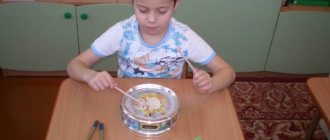WHAT IS PHONEMIC PERCEPTION?
Phonemic perception is the ability to perceive words through the perception of sounds, to determine how many sounds and syllables there are in a word, which consonant sound is at the end of the word and which one is in front, which vowel is in the middle, etc.
Sometimes parents come to see a specialist with the words: “My child has porridge in his mouth.” This is exactly how the speech of a child who has problems with phonemic perception is perceived.
When phonemic perception is formed correctly, the child will pronounce sounds and words correctly, the pronunciation will be clear and clear, he can easily learn to read and write, and will master the grammatical structure of speech.
The foundation for the development of phonemic awareness is considered to be the correct development of listening comprehension. Therefore, children who have problems with phonemic perception suffer from impaired auditory function.
The child’s vocabulary is not replenished with new words that contain sounds that are difficult to distinguish. It follows that the grammatical structure of speech is not formed.
In this regard, the child lags behind his peers in development.
In this article we will talk about age norms in ontogenesis and the stages of language phoneme acquisition.
Why is it necessary to develop it?
Without understanding the sound features of the speech of others, it will be difficult for a child to learn to speak. With developed phonemic hearing, the baby realizes that he is pronouncing the word incorrectly and tries to independently achieve the correct pronunciation. If the difference between similar sounds is not caught, stable substitutions “beetle - kuk”, “shishka - detective” are formed. The worse the phonemic hearing is developed, the more pronounced the speech problems. In such cases, they say that children feel like they have porridge in their mouth.
If a problem is not solved in preschool age, many new, much more serious ones arise from it. The child has difficulty reading, writing, and learning other languages. He has difficulty merging syllables, isolating individual sounds, he writes endings incorrectly, and much more. Schoolchildren begin to fall seriously behind in their school curriculum.
LEVELS OF SPEECH PERCEPTION
Speaking about phonetics, there are two levels of speech perception.
| Phonemic (sensorimotor) level | Phonological (linguistic) level |
| This is the ability to distinguish speech sounds by ear and produce them through articulation. In essence, this is the general sound of speech. | Speech recognition at the phoneme level. The ability to determine the sound sequence and number of sounds in a word. |
The speech that a child hears is a rather difficult and unstable sound process. The child’s task is to find sounds and sound connections with the help of which one can distinguish the meaning of what is being said.
But the child must also be able to generalize speech sounds, this is called the semantic role of language.
www.Logopedy.ru
Chizhikova Tatyana Yurievna, teacher-speech therapist, Municipal Educational Institution Secondary School No. 4, Kopeisk
Original:
Certificate of publication: not issued
An analysis of the current situation in the system of education and training of preschool children has shown that the number of children with speech development disorders is steadily growing. Minimal dysarthric disorders (MDD) are very common in children with ODD (50-80%). These children constitute the main risk group for school failure, especially when mastering writing and reading. [10]
The problem of identifying and correcting minimal dysarthric disorders continues to be relevant to this day. There are numerous indications in the literature that in speech therapy practice children have pronunciation deficiencies. Existing methods for correcting minimal dysarthric disorders in preschoolers do not solve the problem in full.
In order for the child to avoid distortions and substitutions of sounds, close interaction between sensory and motor functions is necessary to ensure the unity of the speech system. R.E. Levina, M.E. Khvattsev, N.H. Shvachkin and others argued that for the correct formation of the sound side of speech, the child must not only have an articulatory apparatus prepared for this, but also be able to hear well and distinguish between correctly and incorrectly pronounced sounds in his own and others’ speech.
It is important that children develop phonemic processes, which in turn control the continuous flow of syllables.
The purpose of our study was to identify the features of the formation of phonemic processes in children of senior preschool age with minimal dysarthric disorders.
Phonemic hearing is one of the components of speech hearing and includes: phonemic perception, phonemic analysis and synthesis, phonemic representations[12].
Many authors have dealt with the problem of studying MDR. In the works of G. G. Gutzman, L. V. Melekhova, O. V. Pravdina, I. I. Panchenko, O. A. Tokareva [10, 6, 7, 11], R. I. Martynova [5] The issues of symptomatology of dysarthric speech disorders, in which there is “washiness” and “erasure” of articulation, are considered. In the works of I.B. Karelina, L.V. Lopatina, N.V. Serebryakova, [1, 3] E.Ya. Sizova E.K. Makarova [8] and E.F. Sobotovich [9] raises issues of diagnosis, differentiation of training and speech therapy work in groups of preschool children with erased dysarthria.
I. B. Karelina introduced new terminology, where erased dysarthria is interpreted as minimal dysarthric disorders - MDD.
Erased dysarthria or MDD is a speech pathology that manifests itself in disorders of the phonetic and prosodic components of the speech functional system and arises as a result of unexpressed microorganic damage to the brain. [10]
To understand the nature and mechanism of speech impairment in MDD, it is necessary to refer to the teachings on the mechanisms of speech by P.K. Anokhin, A.R. Luria, etc.[4]
The authors argued that the mechanisms of speech are associated with a holistic, hierarchical organization of brain activity, including several links, each of which makes its own specific contribution to the nature of speech activity; the first link of the speech functional system is the receptors of hearing, vision, and sensitivity that perceive the initial information. The systems of the initial receptive level also include kinesthetic sensations, which signal the position of the organs of articulation and the whole body. If speech kinesthesia is insufficient, the development of speech is disrupted; the second link is complex cortical systems that process, store incoming information, develop a response program and translate the original semantic thought into a scheme of a detailed speech utterance. The third link of the speech functional system implements the transmission of voice messages. This link has a complex sensorimotor organization. When the third link of the speech functional system is damaged, the innervation of the speech muscles is disrupted, i.e. The motor mechanism of speech is directly disrupted.
R.E. Levina [2], L.V. Lopatina, N.V. Serebryakova [4], M.E. Khvattsev [10] argue that disturbances in the formation of phonemic hearing in children with erased dysarthria may be secondary.
L.V. Lopatina[3] notes that in children with MDD, the existence of unclear articulatory images leads to blurring of the lines between auditory differential features of sounds, namely, with erased dysarthria due to the presence of pathological symptoms in the articulatory apparatus (hypertonicity, hypotonicity , deviation, hyperkinesis, hypersalivation, etc.) the motility of the articulatory organs is disrupted, and the quality of articulatory movements deteriorates. This motor deficiency has a negative impact on the formation of phonemic hearing. Violations of this first link prevent the full assimilation during the learning process of mental operations that make up phonemic perception. In this regard, phonemic concepts, skills and abilities to carry out phonemic analysis in mental terms are not formed.
The experimental part of our study was carried out on the basis of the preschool educational institution kindergarten No. 27 in Kopeisk. The experiment involved 2 groups of children of 10 people each. The experimental group (EG) included children of senior preschool age with MDD and ODD (III level), and the control group (CG) included children of senior preschool age with ODD (III level) without MDD.
The study of phonemic processes in children of senior preschool age with MDD was carried out using a diagnostic technique developed by G. V. Chirkina [13]. The diagnostic difficulty in analyzing the manifestations of deficiencies in phonemic processes was that often the gnostic function of phoneme formation in children with severe articulation defects develops in inferior conditions and may also be insufficient. G.V. Chirkina argued that when analyzing speech disorders, speech activity should be considered as a complex multi-level functional system, the components of which depend on one another and condition each other.
In order to identify possible causes of violations of phonemic processes, the features of phonemic analysis were studied. The study of the state of phonemic analysis was carried out in two stages. At the first stage, the features of simple phonemic analysis were identified, using techniques such as isolating a sound against the background of a word, isolating a sound from a word. At the second stage, the features of complex phonemic analysis were identified; the following techniques were used: determining the place of a sound in a word, determining the sequence of sounds in a word, determining the number of sounds in a word.
To identify violations of the formation of phonemic synthesis, children were offered words of 3-5 words with a preserved sound-syllable structure. They had to listen to the sounds and put them next to each other to form words. Words with a broken sound-syllable structure were also offered; children had to listen to an unusual word and put the sounds correctly to make a familiar word.
The level of formation of phonemic representations of preschoolers was established using such techniques as selecting a word with a certain sound; children were also offered tasks in which they had to sort pictures with oppositional sounds, for example, [S] - [Z] into two groups.
As a result of the survey, we found that in the EG the level of completion of the proposed tasks largely lags behind the level of completion of tasks in the CG.
The study of the state of phonemic hearing revealed the following types of disorders in the subjects of the experimental group.
In tasks to study the discrimination of sounds in syllables and words. 4 children from the EG did not cope with the task of distinguishing sounds in syllables. All children experienced pronounced difficulties in differentiating syllables and phonemes. In this task, children were asked to identify phonemes based on the material of syllables that consisted of sounds that were oppositional and distant in the method and place of formation. Children had difficulty identifying acoustically close sounds. When studying the differentiation of syllables and phonemes, one-third of the children revealed auditory-verbal memory impairments.
Difficulties arose not only when differentiating sounds that differed in subtle acoustic-articulatory features, but also when distinguishing more contrasting sounds. It was also found that children often liken the second syllable to the first and rearrange syllables in a chain of words. This is due to a violation of the auditory-verbal memory of children, as a result of which they cannot learn these chains of syllables.
In the task of distinguishing sounds in words, 8 children from the EG did not cope with the task; they had difficulty completing tasks of identifying and distinguishing words with similar sound compositions.
In the CG we received the following results: when studying the discrimination of sounds by ear using the material of syllables, 1 child did not cope with the task, and using the material of words – 5 children. There was insufficient differentiation of those sounds that were impaired in children's sound pronunciation.
Studying the state of phonemic analysis gave us the following results: 4 children from the EG did not cope with the task. In simple phonemic analysis exercises, children experienced difficulty in tasks that involved identifying sounds from words. In tasks for the study of complex phonemic analysis, great difficulties are caused by tasks with determining the place of a sound in a word and determining the number of sounds in a word, so only 3 children coped with this task.
When conducting the experiment in the second, control group, we revealed the following results.
In tasks to study the state of phonemic analysis, 3 children completely coped with the task, the remaining 7 experienced difficulties either in tasks to study simple phonemic analysis or complex ones. Children from the CG experienced difficulties in complex phonemic analysis tasks, where they needed to determine the place of a sound in a word.
An analysis of tasks to study the state of phonemic synthesis in the experimental group showed that 5 children completed the task. The remaining 5 had difficulty composing words with a broken sound-syllable structure.
In studying the state of phonemic representations in the EG, we received the following results: 7 children did not cope with the task where they had to come up with a word with a given sound. Selecting pictures for a given sound did not cause any particular difficulties for the children; 4 children failed to cope with this task.
When analyzing the results of the third task in the control group, the following data were obtained: 3 children failed. Difficulties were caused by tasks where children needed to correctly place sounds in words with a broken sound-syllable structure.
During the fourth task in the CG, 5 children completely coped with the task, the remaining 5 had difficulty either selecting a word for a given sound or selecting pictures.
Thus, in children from the EG, phonemic processes are sharply impaired. Phonemic hearing impairment manifests itself in difficulties in distinguishing both close and distant phonetically and articulatory sounds, which results in disturbances in the formation of phonemic analysis, phonemic synthesis and phonemic representations. It was found that children with MDD and ODD (level III) have auditory-verbal memory impairments.
In the CG the level of task completion was significantly higher. This is explained by the fact that MDD, as an initial defect, leads to a lack of phonemic perception, analysis, and synthesis, since the blurred, slurred speech of these children does not provide the opportunity for the formation of clear auditory perception and control.
Bibliography
1. Karelina, I.B. New directions in the correction of minimal dysarthric disorders // Defectology. – 2000. – No. 1. – P. 24-26.
2. Levina, R. E. Pedagogical issues of speech pathology in children / R. E. Levina. - Special school, 1967. – 267 p.
3. Lopatina, L. V. Speech therapy work in preschool groups. with an erased form of dysarthria / L. V. Lopatina, I. N. Serebryakova. – St. Petersburg. : Education, 1994. – 191 p.
4. Luria, A. R. Higher cortical functions of humans and their disorders in local brain lesions / A. R. Luria. – 2nd add. ed., M., 1969. – 505 p.
5. Martynova R.I. Comparative characteristics of children suffering from mild forms of dysarthria and functional dyslalia // Speech disorders and methods of their elimination / Ed. S.S. Lyapidevsky and S.N. Shakhovskaya. – M., 1975.- P. 29-33
6. Melekhova, L. V. Differentiation of dyslalia // Reader on speech therapy / Ed. L. S. Volkova and V. I. Seliverstov. – M.: VLADOS, 1997/ — p/ 29-33/
7. Panchenko, I. I. Features of phonetic-phonemic analysis of sound pronunciation disorders and some principles of therapeutic and corrective measures for dyslastic and dysarthric disorders // Speech and voice disorders in childhood / Ed. Lyapidevsky S.S. – M., 1973.
8. Sizova, E. Ya. About the mechanisms of lateral sigmatism // Mental and speech disorders in children. Issues of rehabilitation / E. Ya. Sizova, E. K. Makarova. - M.: 1979. – 261 p.
9. Sobotovich, E. F. Manifestations of erased dysarthria and methods of their diagnosis / E. F. Sobotovich, A. F. Chernopolskaya // Defectology. - 1974. - No. 4. – pp. 20-26
10. Erased dysarthria in children: study. manual for university students / E. F. Arkhipova. – M.: AST: Astrel: KHRANITEL, 2007. – 319.
11. Tokareva, O. E. Dysarthria // Speech disorders in children and adolescents / edited by. ed. S. S. Lyapidevsky. - M.: Medicine 1969.- 201 p.
12. Cherkasova, E. L. Speech impairment in minimal disorders of auditory function (diagnosis and correction): textbook. manual for pedagogical students. universities with a degree in defectology. – M.: ARKTI, 2003. – 192 p.
13. Chirkina, G.V. Methods for examining children's speech: a manual for diagnosing speech disorders/ Ed. total ed. G.V. Chirkina – 3rd ed., add. – M.6 ARKTI, 2003. – 240 p.
Social commentary Cackle
ONTOGENETIC FEATURES OF THE DEVELOPMENT OF PHONEMATIC PERCEPTION
In ontogenesis, phonemic hearing occurs spontaneously and at a very early age.
When a baby is two weeks old, hearing a noise or someone's voice, he stops crying, becomes quiet, or is distracted from the feeding process.
In the table below I will talk about age norms for the development of phonemic awareness.
| Pre-phonemic stage of speech development (speech understanding is not developed) | |
| Embryonic development | The ability to perceive speech sounds begins to develop. |
| 1-2 months | The child reacts to external noise vibrations: rattles, voices, melodies, etc. |
| 2-3 months | The child begins to look for where the sound is coming from: twisting his head, turning over in the right direction. |
| 3-6 months | The child already finds sound sources with his eyes, can distinguish voices, and determines the intonation of the voice (affectionate or strict). Reacts differently to calm and active melodies |
| Phonemic stage (language) | |
| 6-7 months | The baby no longer just hears different sounds, but learns to perceive the speech he hears. A large semantic role during this period is given to rhythm recognition skills. |
| 7-8 months | The child understands many words, including the names of the objects he sees. |
| 9-12 months | Along with recognizing intonation and rhythms, the child begins to extract a sound pattern that forms a word. |
| 2 years | At this age, the child understands and can distinguish words that differ in only one phoneme, for example, “Dew-braid.” The child develops a perception of speech sounds. |
| 3 years | The child is able to distinguish between vowels and consonants, hissing/whistles, soft/hard, sonorant sounds (voiced consonants with minimal noise) |
| 4 years | The child distinguishes all sounds. At this age, the formation of phonemic perception and pronunciation of sounds continues. |
| Final stages | |
| 5 years | Spontaneous phonemic development is completed. The child is able to distinguish between images of objects and sounds separately. |
| 6-7 years | Full awareness of the sound side of words comes |
The phonemic perception of sounds itself is formed as a result of the mutual connection of auditory and kinesthetic vibrations that enter the cerebral cortex.
Distinguishing words that are similar in sound composition
Exercise 3 Repeat two words after an adult and determine whether they sound similar:
|
|
|
Exercise 4 Repeat after the adult, first two then three similar words in the given order:
|
|
Exercise 5 An adult clearly pronounces pairs of words and asks the child to determine whether the names he hears are the same or different:
|
|
Exercise 6
Of the four words spoken by an adult, the child must choose and name the word that is different from the rest:
- com - com - cat - com
- ditch - cocoa - ditch - ditch
- duckling - duckling - duckling - kitten
- booth - letter - booth - booth
- screw - screw - screw - bandage
- minute - coin - minute - minute
- buffet - bouquet - buffet - buffet
- Ticket - ballet - ballet - ballet
- pipe - booth - booth - booth
Exercise 7
An adult invites the child to finish the couplet by choosing a suitable rhyming word:
| I dropped the briefcase from my hands, it was so big on the branch... (beetle). A nimble bear was walking through the forest, and... (a bump) fell on him. There are evil animals here in the forest, Lock them at night... (doors). We collected cornflowers on our heads... (wreaths). And back and forth It can sail... (steamboat). | Hush, Tanechka, don’t cry, Don’t drown in the river... (ball). One evening two mice took Petya away... (books). Vlad doesn’t crawl onto the spruce tree. In his hands... (briefcase). The dog brought a bouquet to the goat, It will be filling for her... (lunch). Don’t tremble, Seryozhka, this is ours... (cat). |
Examples of exercises
Games for the development of phonemic hearing are numerous and varied, so a separate article is devoted to them. Some examples of exercises:
- "Confusion". Task: clap your hands when pronouncing the word correctly. The child is shown a picture, for example, of a saucepan. First, the adult loudly and clearly pronounces the correct name (introduces it to the baby). Then he begins to deliberately distort: tastryulya, sastryulya, bastrulya, dastryulya. About halfway through, “pan” is pronounced correctly, and this point is indicated by a clap. Then the picture and word change.
- "Extra sound." Task: eliminate the extra syllable (word). An adult clearly pronounces: ta-ta-ta-da-ta, sa-za-sa-sa-sa, cat-cat-that-cat.
- "The sound got lost." Task: Understand what is wrong in the sentence and correct it. Example: in the spring, the lights (flowers) bloomed, oak trees (teeth) grew in the mouth, the puppy lives in a bun (kennel), the mother braided her kidney (daughter’s) braid.
- "Where is the sound?". Game for schoolchildren. Task: place the chip correctly on the card with the word. For example, an adult calls the sound “U”, and puts a card with the word “Dinner” in front of the child. The correct location of the chip is the first letter.
To develop phonemic awareness and hearing, it is useful for children to read age-appropriate books, speak competently and clearly in their presence, and use different intonations and volume of speech. Special attention should be paid to active cognition of the surrounding world, training visual, auditory, tactile and other analyzers.
Probable Causes
The development of phonemic hearing is influenced by the upbringing environment, the example of speech in the family, the state of the peripheral nervous system, etc.
Among the most likely causes of the violation are the following:
- pedagogical neglect;
- hearing loss;
- head injuries, hearing and speech pathologies;
- hyperactivity;
- weakening of the body, serious or frequent illnesses, especially at an early age;
- diseases of the thyroid gland and digestive organs;
- neurological disorders.
To identify the exact cause, it is necessary to consult an ENT specialist, neurologist and speech therapist as early as possible. Sometimes, in addition to the development of phonemic hearing, drug or surgical treatment is required: cutting the hypoglossal ligament, taking central nervous system stimulants.
Phonemic hearing is very important for the development of correct speech. It is necessary not to miss the moment and pay due attention to it at the age of 4–6, so that the child learns easily at school and does not face ridicule from his peers. It is better if the method of hearing development is developed individually, taking into account all the characteristics of the baby.
Signs of violation
First of all, undeveloped phonemic hearing is indicated by a lack of understanding of the addressed speech, complete or partial. For example, if a child cannot complete simple tasks, he often asks questions or understands requests incorrectly. The second alarming sign is speech defects. The speech-auditory and speech-motor analyzers are closely related and have a significant influence on each other.
At 4 years old, a child normally speaks in phrases, uses prepositions, and is able to ask questions. By 5–6 years, all sounds except “R” are pronounced correctly, and endings are used correctly. In addition, a preschooler can easily name the first sound in a word and choose other words for it. There are 3 signs of phonemic hearing impairment (at 5 years):
- defects in sound pronunciation (for example, replacing hard sounds with soft ones);
- skipping sounds in words, rearranging them, using unnecessary sounds (fairy tale - sazka, umbrella - zotnik, butter - maslo);
- slight difference between similar sounds in oral speech and in writing s-sh, z-zh, d-t, etc. (zhuk - zuk, doctor - toctor, drying - shushka).
In schoolchildren, phonemic hearing disorders manifest themselves in slow reading and difficulty merging syllables. There are invariably errors in writing, the child hears incorrectly and writes the same way (double consonants, voiceless words at the end, unstressed vowels).
Development methods
It is possible to develop phonemic awareness only gradually. First, the child learns to recognize sounds that are not similar to each other, then learns about correct and incorrect pronunciation, and begins to find errors in familiar words. Next, the ability to conduct phonemic analysis, isolate sounds in parts of a word (beginning, middle, end), and select a rhyme is formed. At the final stage, already at school, the child can determine the quantitative sound composition of a word. He develops the ability to use test words and understand the rules.
The method of developing phonemic hearing is based on developing the ability to navigate the sound side of a word. Training is carried out in the form of a game and includes the following exercises:
- articulatory gymnastics aimed at improving the mobility of the tongue, lips, etc.;
- breathing exercises that allow you to correctly direct the air stream (for example, exercise “Candle”, “Feather”);
- education of intonation expressiveness of speech;
- developing the ability to control the power of the voice;
- classes on the correct pronunciation of all sounds;
- sound analysis of words (selection of similar and different-sounding words, identification of soft and hard sounds, ringing, murmuring, hissing, etc.);
- games with words (for example, choose a word that begins with a certain sound).
In this case, it is necessary to take into account the individual characteristics of the child, the upbringing environment, structural defects of the speech apparatus (short hyoid ligament, small and narrow tongue, open bite, etc.). Also, when developing phonemic hearing, one should take into account the sequence of distinguishing sounds - first vowels, then noisy and sonorant consonants, hard and soft, labial - lingual, deaf - voiced, hissing - whistling.
At what age should you start classes?
The process of developing phonemic hearing in children is individual. It happens that a child begins to perfectly catch sounds and speak at 1.5–2 years. But more often, active formation occurs at the age of 4 years and continues until 5–6 years. At the same time, the most sensitive and significant period of development remains the first years of life.
If up to 2 years of age you talk to your child correctly, without babying, read poems that he understands, and learn simple phrases, then the risk of phonemic hearing disorders decreases significantly. In other words, classes can be conducted from a very early preschool age. There are a lot of exercises and games for the development of phonemic hearing in children 1 year old, 2-3 years old and older. In each case, tasks are selected that correspond to the child’s capabilities.
Important. The optimal time for the development of phonemic hearing is preschool age. Further solving existing problems will become increasingly difficult, and after 9 years it will be almost impossible.






